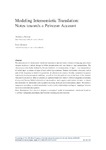Modeling intersemiotic translation: Notes towards a Peircean Account

Ver/
Use este enlace para citar
http://hdl.handle.net/2183/13326Coleccións
Metadatos
Mostrar o rexistro completo do ítemTítulo
Modeling intersemiotic translation: Notes towards a Peircean AccountData
2012Cita bibliográfica
Culture of communication / Communication of culture, 2012: 337-343. ISBN: 978-84-9749-522-6
Resumo
[Abstract] The phenomenon of intersemiotic translation represents a special creative domain of language procedures because involves a radical change in habits interpretation and new forms of sign manipulation. The phenomenon was firstly defined by Roman Jakobson as transmutation of signs – «an interpretation of verbal signs by means of signs of non verbal sign systems». Despite its theoretic relevance, and in spite of the frequency in which it is practiced, the phenomenon remains virtually unexplored in general explanatory levels (conceptual modeling), as well as from the point of view of the logic of the semiotic processes involved in it. Here we propose an approach based on Charles S. Peirce’s pragmatic philosophy of sign and Stanley Salthe’s hierarchical structuralism, and suggest a preliminary division in classes and modalities of translations with examples involving literature and contemporary dance. We defend a perspective according to which translations involve iconic relationships (analogical mappings) between multi-structured semiotic systems. Short Description: Our aim is to propose a conceptual model of intersemiotic translation based on C.S.Peirce’s pragmatic philosophy and S.Salthe’s hierarquical structuralism.
ISBN
978-84-9749-522-6





